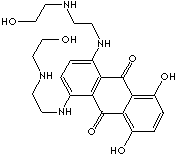PRODUCT IDENTIFICATION
70476-82-3 (Dihydrochloride)

H.S. CODE
TOXICITY
C1=CC(=C2C(=C1NCCNCCO)C(=O)C3=C(C=CC(=C3C2=O)O)O)NCC NCC O.Cl.Cl
CLASSIFICATION
Antineoplastic, Immunomodulator, Topoisomerase II Inhibitor
EXTRA NOTES
PHYSICAL AND CHEMICAL PROPERTIES
SOLVENT SOLUBILITY
Slightly soluble in methanol. Practically insoluble in acetonitrile, chloroform, acetone
REFRACTIVE INDEX
Stable under ordinary conditions. Hygroscopic
EXTERNAL LINKS & GENERAL DESCRIPTION
Wikipedia Linking - Mitoxantrone
Google Scholar Search - Mitoxantrone
Drug Information Portal (U.S. National Library of Medicine) - Mitoxantrone
PubChem Compound Summary - Mitoxantrone dihydrochloride
Drug Bank - Mitoxantrone
KEGG (Kyoto Encyclopedia of Genes and Genomes) - Mitoxantrone
http://www.ebi.ac.uk/ - Mitoxantrone
http://www.ncbi.nlm.nih.gov/ - Mitoxantrone
http://toxnet.nlm.nih.gov/
Hazardous Substances Data Bank - Mitoxantrone
http://dailymed.nlm.nih.gov/
Mechanism of Action - Mitoxantrone, a DNA-reactive agent that intercalates into deoxyribonucleic acid (DNA) through hydrogen bonding, causes crosslinks and strand breaks. Mitoxantrone also interferes with ribonucleic acid (RNA) and is a potent inhibitor of topoisomerase II, an enzyme responsible for uncoiling and repairing damaged DNA. It has a cytocidal effect on both proliferating and nonproliferating cultured human cells, suggesting lack of cell cycle phase specificity. Mitoxantrone injection has been shown in vitro to inhibit B cell, T cell, and macrophage proliferation and impair antigen presentation, as well as the secretion of interferon gamma, TNFα, and IL-2.
Local:
Mitoxantrone, an anthraquinone class antineoplastic agent, is used to treat acute nonlymphocytic leukemia. Its chemical designation is 1,4-Dihydroxy-5,8-bis(2-((2-hydroxyethyl) amino) ethyl)amino) anthraquinone. The hydrochloride salt of mitoxantrone is administered intravenously; a blue to black powder. Urine may turn a blue color by the drug.
Topoisomerase inhibitor is a substance that blocks topoisomerases (enzymes that break and rejoin DNA strands and are needed for cells to divide and grow). Blocking these enzymes may kill cancer cells. Certain topoisomerase inhibitors are being studied in the treatment of cancer.
| Topoisomerase inhibitor |
CAS RN. |
|
Aclarubicin |
57576-44-0 |
|
Amrubicin |
110267-81-7 |
| Amsacrine | 51264-14-3 |
| Belotecan Hydrochloride | 213819-48-8 |
|
Belotecan |
256411-32-2 |
|
Camptothecin |
|
|
Daunorubicin |
20830-81-3 |
| Daunorubicin hydrochloride | 23541-50-6 |
|
Doxorubicin |
23214-92-8 |
| Doxorubicin hydrochloride | 25316-40-9 |
| Doxorubicin citrate | 111266-55-8 |
| Edotecarin | 174402-32-5 |
|
Epirubicin |
56420-45-2 |
| Epirubicin hydrochloride | 56390-09-1 |
| Etoposide | 33419-42-0 |
| Etoposide phosphate | 117091-64-2 |
|
Idarubicin |
58957-92-9 |
| Idarubicin | 58957-92-9 |
| Idronoxil | 81267-65-4 |
| Irinotecan hydrochloride | 136572-09-3 |
|
Irinotecan |
97682-44-5 |
| Ledoxantrone trihydrochloride | 119221-49-7 |
| Lurtotecan dihydrochloride | 155773-58-3 |
| Mitoxantrone | 65271-80-9 |
| Mitoxantrone hydrochloride | 70476-82-3 |
|
Pirarubicin |
72496-41-4 |
|
Pixantrone |
144510-96-3 |
| Pixantrone maleate | 144675-97-8 |
| Rubitecan | 91421-42-0 |
| Temafloxacin hydrochloride | 105784-61-0 |
|
Teniposide |
29767-20-2 |
| Topotecan | 70476-82-3 |
| Topotecan hydrochloride | 119413-54-6 |
|
Valrubicin |
56124-62-0 |
|
Zorubicin |
54083-22-6 |
APPEARANCE
PURITY
98.0 - 102.0%
IDENTIFICATION
Complies
INDIVIDUAL IMPURITY
0.5% max (Total 1.0% max)
ETHYL ALCOHOL
0.2% max
WATER
6.0% max
HEAVY METALS
20ppm max
HAZARD OVERVIEW
OSHA Hazards Target Organ Effect, Carcinogen, Teratogen. Target Organs:Bone marrow, Heart, Central nervous system, Liver. GHS Classification:Reproductive toxicity (Category 1B). May damage fertility or the unborn child.
GHS
Danger
PICTOGRAMS

HAZARD STATEMENTS
H360
P STATEMENTS
P201-P308 + P313
![]() T
T
RISK PHRASES
46-61
SAFETY PHRASES
53-36/37/39-45